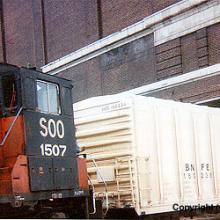861 Hits for February 2013
Albums (0) & Images (861)
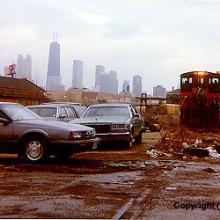
tb_Morgan_1990_01
The local CP Rail switch job is working a food company warehouse in early 1990 on a gray, Chicago winter day. The location is Morgan St. at Carroll Ave., just north of the CP Rail main line. This switch job used the same crew as the Kingsbury line and worked alternate days to the North Side operation. With the rapid redevelopment of the West Loop area in the 1990s, this area is now almost unrecognizable and this particular switching operation is now history. The Soo Line crew backs down the spur to pick up empty cars inside the warehouse building just ahead. Note the abandoned track segment now paved over on the left, and the rest of the train, including a Milwaukee Road caboose, waiting in the background. In the distance are the remains of the once extensive Milwaukee Road freight terminal.tb_Morgan_1990_01
The local CP Rail switch job is working a food company warehouse in early 1990 on a gray, Chicago winter day. The location is Morgan St. at Carroll Ave., just north of the CP Rail main line. This switch job used the same crew as the Kingsbury line and worked alternate days to the North Side operation. With the rapid redevelopment of the West Loop area in the 1990s, this area is now almost unrecognizable and this particular switching operation is now history.
The Soo Line crew backs down the spur to pick up empty cars inside the warehouse building just ahead. Note the abandoned track segment now paved over on the left, and the rest of the train, including a Milwaukee Road caboose, waiting in the background. In the distance are the remains of the once extensive Milwaukee Road freight terminal.

tb_Morgan_1990_02
Soo Line conductor ("Paul") steps down to flag traffic and set the switch on Morgan St. as the MP-15 eases toward the warehouse and its two spur tracks inside.tb_Morgan_1990_02
Soo Line conductor ("Paul") steps down to flag traffic and set the
switch on Morgan St. as the MP-15 eases toward the warehouse and
its two spur tracks inside.
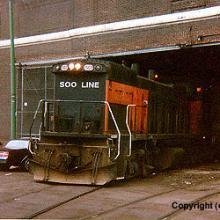
tb_Morgan_1990_03
The MP-15 gingerly backs into the building and couples onto a white boxcar. There's another empty boxcar in the spur to the right (north) which needs to be removed next.tb_Morgan_1990_03
The MP-15 gingerly backs into the building and couples onto a white
boxcar. There's another empty boxcar in the spur to the right
(north) which needs to be removed next.
The first car is pulled out of the building!
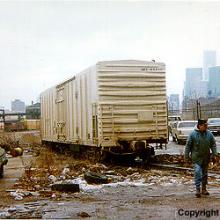
tb_Morgan_1990_05
The crew slowly moves the train out past the switch and prepares to back down the second spur in the building to remove the remaining empty car. Paul steps onto Morgan once again to flag traffic and throw the switch. The train will back into the spur and couple the white boxcar onto the brown boxcar, pulling both back out together.tb_Morgan_1990_05
The crew slowly moves the train out past the switch and prepares to back down the second spur in the building to remove the remaining empty car. Paul steps onto Morgan once again to flag traffic and throw the switch. The train will back into the spur and couple the white boxcar onto the brown boxcar, pulling both back out together.
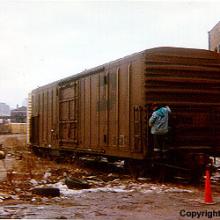
tb_Morgan_1990_06
Job complete, the MP-15 and the two boxcars head back to the rest of the train in the distance.tb_Morgan_1990_06
Job complete, the MP-15 and the two boxcars head back to the rest of the train in the distance.
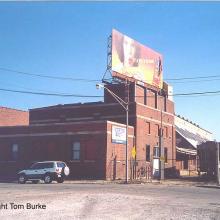
tb_mortonsalt_0904_01
This view looks south at the Morton Salt plant on Elston Ave. on Chicago's North Side. It receives carloads of salt in covered hoppers off the UP near the North Ave. yard. The Morton Salt painted sign on the salt shed has been a Chicago landmark for years for people traveling on the nearby Kennedy Expressway or Metra trains. Morton uses a tractor to move the cars around inside the fenced grounds.tb_mortonsalt_0904_01
This view looks south at the Morton Salt plant on Elston Ave. on
Chicago's North Side. It receives carloads of salt in covered
hoppers off the UP near the North Ave. yard. The Morton Salt
painted sign on the salt shed has been a Chicago landmark for years
for people traveling on the nearby Kennedy Expressway or Metra
trains. Morton uses a tractor to move the cars around inside the
fenced grounds.
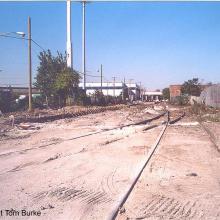
tb_mortonsalt_0904_02
The camera is turned around 180 degrees to capture the tracks used by the UP to switch out Morton Salt on Magnolia. On this September 2004 afternoon Magnolia St. is under construction. The UP uses the track which continues in the distance as a tail track for backing freight cars into the Morton Salt plant. At one time the tracks traveled across North Ave. and served the huge Proctor & Gamble factory which was torn down in the early 1990s, along with other industries along Magnolia. A scrap yard used to receive gondolas off the UP and C&NW to the right or east until a few years ago.tb_mortonsalt_0904_02
The camera is turned around 180 degrees to capture the tracks used
by the UP to switch out Morton Salt on Magnolia. On this September
2004 afternoon Magnolia St. is under construction. The UP uses the
track which continues in the distance as a tail track for backing
freight cars into the Morton Salt plant. At one time the tracks
traveled across North Ave. and served the huge Proctor & Gamble
factory which was torn down in the early 1990s, along with other
industries along Magnolia. A scrap yard used to receive gondolas
off the UP and C&NW to the right or east until a few years ago.
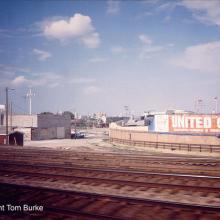
tb_mortonspur_06112005_03
Here's a look at the spur which once served several industries along Elston and Magnolia Avenues in Chicago, including the massive Proctor & Gamble plant along North Avenue, a scrapyard, and Morton Salt. Today just Morton Salt is served by rail as the other two industries are now gone. The track on Magnolia was rebuilt in 2004 as part of a street reconstruction project. Just enough was put in place to serve as a tail track for backup moves in the Morton Salt complex. Note the curved brick building to accommodate the track which was more typical of another era.tb_mortonspur_06112005_03
Here's a look at the spur which once served several industries
along Elston and Magnolia Avenues in Chicago, including the massive
Proctor & Gamble plant along North Avenue, a scrapyard, and Morton
Salt. Today just Morton Salt is served by rail as the other two
industries are now gone. The track on Magnolia was rebuilt in 2004
as part of a street reconstruction project. Just enough was put in
place to serve as a tail track for backup moves in the Morton Salt
complex. Note the curved brick building to accommodate the track
which was more typical of another era.
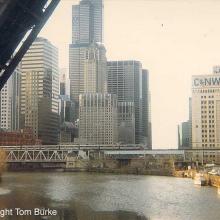
tb_navypierbridge_04041988_03
In 1988 the C&NW was still an independent railroad with headquarters in Chicago. We're looking south here across the C&NW bascule bridge used to reach Navy Pier towards the headquarters building on Canal St. in the distance. Note the C&NW logos.tb_navypierbridge_04041988_03
In 1988 the C&NW was still an independent railroad with
headquarters in Chicago. We're looking south here across the
C&NW bascule bridge used to reach Navy Pier towards the
headquarters building on Canal St. in the distance. Note the
C&NW logos.
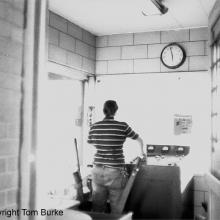
tb_navypierbridge_1988_01
Yes, the picture is overexposed due to light leaking into the camera, but it's still a rare shot of a C&NW tower operator working the levers to lower the bridge over the North Branch of the Chicago River just south of Kinzie St. in 1988.tb_navypierbridge_1988_01
Yes, the picture is overexposed due to light leaking into the
camera, but it's still a rare shot of a C&NW tower operator
working the levers to lower the bridge over the North Branch of the
Chicago River just south of Kinzie St. in 1988.
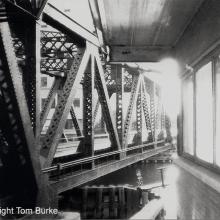
tb_navypierbridge_1988_02
Here's a view of the lowered bridge alongside the tower operator building alongside the river.tb_navypierbridge_1988_02
Here's a view of the lowered bridge alongside the tower operator
building alongside the river.
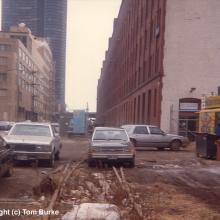
tb_navypier_041987_01
This shot looks due east down Illinois Street and past the North Pier Terminal building on the right. The North Pier Terminal building is already undergoing renovations which will turn it into a popular destination with shops and restaurants. The tracks will soon be history.tb_navypier_041987_01
This shot looks due east down Illinois Street and past the North Pier Terminal building on the right. The North Pier Terminal building is already undergoing renovations which will turn it into a popular destination with shops and restaurants. The tracks will soon be history.
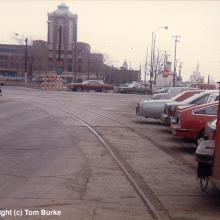
tb_navypier_041987_02
Looking east again, just past Lake Shore Drive and on Illinois St. A switch is under the parked cars just behind the camera. The track that veers to the right is a spur into the City of Chicago water filtration plant which used to receive carloads of chlorine. The track to the right goes on to Navy Pier and will fork twice. The tracks and switches are still there under the gravel and in places, asphalt.Chicago Surface Line streetcars also serviced Navy Pier via Grand Avenue (next street to the left or north) using the ramps shown in this picture to circle around the main buildings.
tb_navypier_041987_02
Looking east again, just past Lake Shore Drive and on Illinois St. A switch is under the parked cars just behind the camera. The track that veers to the right is a spur into the City of Chicago water filtration plant which used to receive carloads of chlorine. The track to the right goes on to Navy Pier and will fork twice. The tracks and switches are still there under the gravel and in places, asphalt.
Chicago Surface Line streetcars also serviced Navy Pier via Grand Avenue (next street to the left or north) using the ramps shown in this picture to circle around the main buildings.
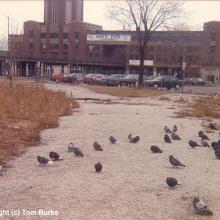
tb_navypier_041987_03
At this junction spot the tracks diverge in front of Navy Pier, with a set traveling to opposite sides. The tracks are buried under gravel. This area today is a popular tourist destination. Back then it was a cheap place to park your car away from the expensive Loop garages.tb_navypier_041987_03
At this junction spot the tracks diverge in front of Navy Pier, with a set traveling to opposite sides. The tracks are buried under gravel. This area today is a popular tourist destination. Back then it was a cheap place to park your car away from the expensive Loop garages.
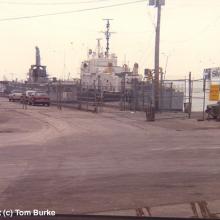
tb_navypier_041987_04
This shot shows the C&NW tracks making their way down the south side of Navy Pier. This rail extension was added in 1956 to encourage trade with large ships via the St. Lawrence Seaway. Two sets of tracks cover this end.tb_navypier_041987_04
This shot shows the C&NW tracks making their way down the south
side of Navy Pier. This rail extension was added in 1956 to
encourage trade with large ships via the St. Lawrence Seaway. Two
sets of tracks cover this end.
